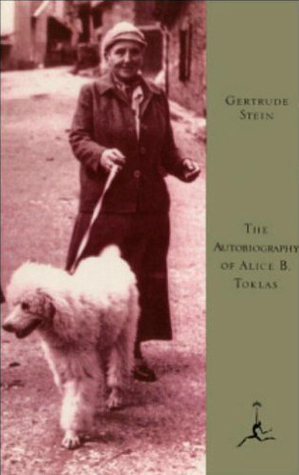

 |

|

The average rating for The autobiography of Alice B. Toklas based on 2 reviews is 4 stars.
Review # 1 was written on 2014-06-25 00:00:00 Craig James Craig James"After a while I murmured to Picasso that I liked his portrait of Gertrude Stein. Yes, he said, everybody says that she does not look like it but that does not make any difference, she will, he said." Well, I can't really say if Gertrude Stein ever looked like Picasso's portrait of her in real life, but in my imagination, there is no other way to see her, exception made for Man Ray's photograph of her in front of the painting which is a brilliant double portrait of the grand lady through two artist lenses: Whoever is in love with the painters and writers who frequented Paris during the first decades of the 20th century must read Gertrude Stein's brilliant account of the era. A woman of exceptional self-confidence, she conquered a world of machismo and made her own creativity the starting point for a whole generation. Matisse, Hemingway, Picasso, Apollinaire ... The guest list in her novel is exquisite. But it never forgets to pay the most enduring tribute to the hostess of the show - Gertrude Stein herself, as seen through the eyes of her lifelong companion, Alice B. Toklas. It is both a novel and an autobiography, and the careful selection and presentation of specific facts and events turn it into a quasi-fictional construction in the spirit of Goethe's autobiography, appropriately called Dichtung und Wahrheit - or "fiction and truth". Gertrude Stein, being a woman, had to face far more severe criticism for believing in her own genius and her right to earn money than any of her male artist friends. Her irony, wit and intelligence speak for themselves, though, and she remains one of the defining voices of her era. The juxtaposition of literary discussions between the masters of the time with seemingly unimportant everyday worries and details is a perfect combination: an overview of a historical phase and an intimate portrait of a woman at the same time. Recommended for Paris lovers and bibliophiles alike - a rare treat! |
Review # 2 was written on 2012-07-09 00:00:00 Joe Strand Joe StrandPablo Picasso! Henri Matisse! Ernest Hemingway! F. Scott Fitzgerald! Sherwood Anderson! T. S. Eliot! Djuna Barnes! Ezra Pound! Georges Braque! Ford Madox Ford! Jean Cocteau! All of these artists and writers were bumping into each other in Paris in the 1920s, often at Gertrude Stein's apartment, the famous salon at 27 rue de Fleurus. (And if you're wondering who the hell Alice B. Toklas is, she was Stein's longtime partner and lover, and calling it an autobiography but yet it was written by Stein was Stein's idea of a joke.) I'll be honest and say I was keen to read this book because I had hoped for some delicious gossip about these famous people, and while there were some good stories, Stein's writing was more difficult to read than I expected. This was my first Stein book, and I would describe her style as a conversational stream of consciousness that frequently turns into babble. Here is a good example of her style: "This was the year 1907. Gertrude Stein was just seeing through the press Three Lives which she was having privately printed, and she was deep in The Making of Americans, her thousand page book. Picasso had just finished his portrait of her which nobody at that time liked except the painter and the painted and which is now so famous, and he had just begun his strange complicated picture of three women, Matisse had just finished his Bonheur de Vivre, his first big composition which gave him the name of fauve or a zoo. It was the moment Max Jacob has since called the heroic age of cubism. I remember not long ago hearing Picasso and Gertrude Stein talking about various things that had happened at the time, one of them said but all that could not have happened in that one year, oh said the other, my dear you forget we were young then and we did a great deal in a year. There are a great many things to tell of what was happening then and what had happened before, which led up to then, but now I must describe what I saw when I came." I did not change anything about that quote -- you get a sense of Stein's run-on sentences and her laissez-faire punctuation. Often when I was reading this book I felt as if I was listening to a confused storyteller, someone who just kept talking and talking and rambling and trying to convey a message, but that they themselves had forgotten what the message was. There were some nice quotes and turns of phrase, such as: "[Stein] was born in Allegheny, Pennsylvania, of a very respectable middle class family. She always says that she is very grateful not to have been born of an intellectual family, she has a horror of what she calls intellectual people." But I had to slog through quite a few pages before I found a quote worth marking. So, why would someone read this book? Maybe you would be brought to it, as I was, by the Woody Allen movie "Midnight in Paris," which had scenes that were inspired by this memoir. Or maybe you want to hear more about Picasso and Matisse and Hemingway, which were my favorite parts of the book. Maybe you want to read about Paris during World War I, and how empty of men the world had seemed then. For me, I'm still fascinated by the Lost Generation and will read more Hemingway and Fitzgerald (because I didn't fully appreciate them when I was younger), but I may have had my fill of Stein for now. |
CAN'T FIND WHAT YOU'RE LOOKING FOR? CLICK HERE!!!